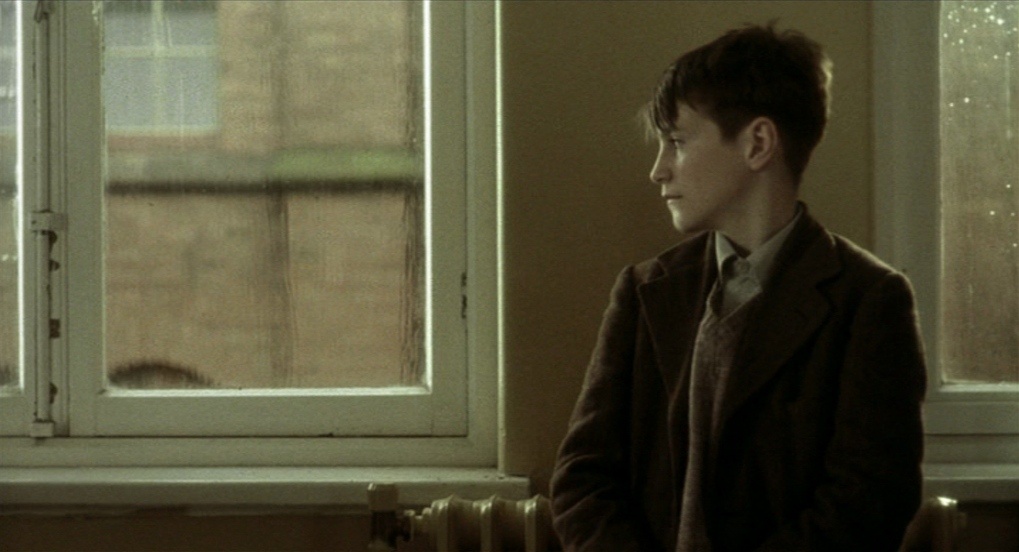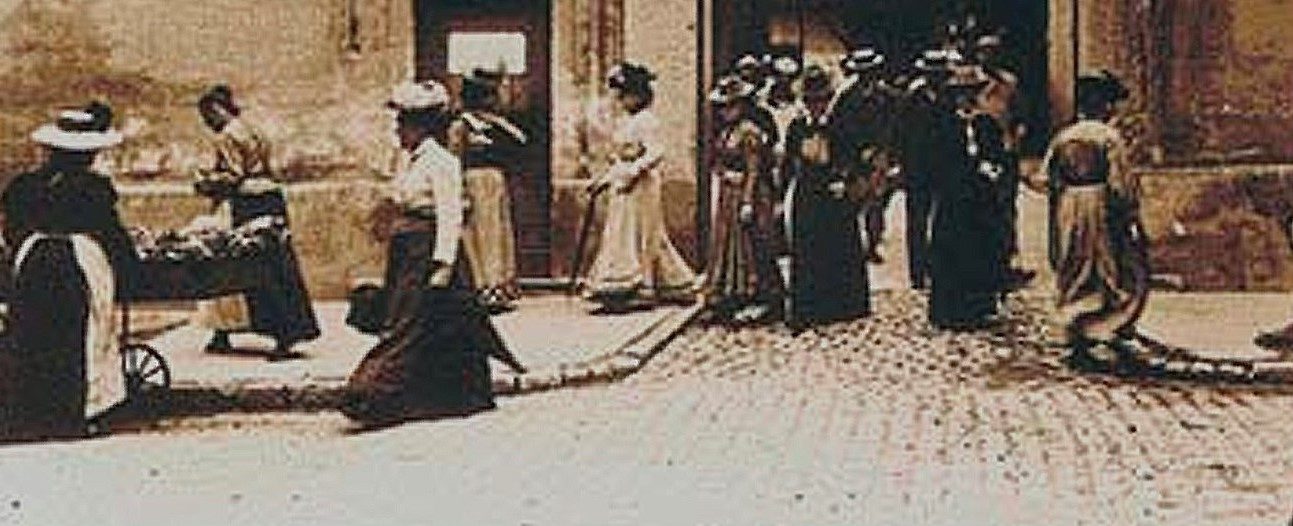United Kingdom, 1992
Directed by Terence Davies
With Leigh McCormack (Bud Davies), Marjorie Yates (the mother), Anthony Watson (Kevin), Nicholas Lamont (John), Ayse Owen (Helen)

“You are not introducing a film!”, the cross female voice from another world, actually from another movie, the 1950 British comedy “The Happiest Days of Your Life”, tells – but then the 20th Century Fox parade is played, rather clumsily, giving way to Nat King Cole’s unforgettable voice crooning romantic and melancholy lyrics which eventually evoke days that have gone by – all the while, the camera has moved away from a dirty brick wall with posters in tatters, panned from left to right very slowly to capture a dark alley under a pouring rain, and then tracks in towards an entrance and past it, revealing a dilapidated interior, with a half-demolished stairway, which, magically, reverts back to its original, solid, clean, decorated form, with a quiet kid caught in a sun beam carefully reckoning the coins he has in his hand.
What a beginning – amazing and baffling, it smoothly weaves together sounds and sights that on the face of it are worlds apart, shards of many spaces and moments of many eras, the very intensity of their collision course blending with the wonderfully smooth, subtle, stylish camerawork to craft a surprising but arresting fluidity. The lady’s reprimand feels ironic and yet she has a point: this is no ordinary film that is starting before the puzzled eyes of the audience who is realizing right away that cinematic techniques, patterns, and even memories are harnessed to express concretely the sense of time passing by, more precisely the individual’s sense that time has been passing, images getting a cue from a stream of distant and variegated sounds as if they were the first blocks on which memories are built. A line from a film, an old tune, traditional songs, bring about the many vignettes the film is made of, while the images gracefully emerge from a slow motion of the camera, usually tracking sideways, panning one way or another too, and sometimes just standing still waiting for the frame to open, close, or alter, a delicate superimposition, a bold move of a character seemingly starting an unambiguous action that in fact leads to another world. And the first images look even more striking as it becomes plain that indeed they introduced the elaborate, refined, spellbinding logic the director has conceived and is to apply rigorously.
“The Long Day Closes” could be likened to a coming of age story and look like a period piece chronicle. But the usual narrative and genre categories are rather irrelevant to grasp what the film shows. There is no real plot, with narrative arcs and twists and turns: this is a collection of moments in the life of Bud Davies, an 11-year old boy of a Catholic working class family in northern England in 1955-1956. He has lost his father and lives with a mother he adores and three siblings far older than him, already starting an adult life, working and flirting, Kevin, John, and Helen. He is to leave the primary school to enter the junior high school – he is now a big boy – but if it allows the film to expose how harsh and depressing education was back then, the change is no pretext to a real narrative, the camera never lingering on this part of Bud Davies’ life, nor actually does it ever focus long on any other aspect, from home routines to religious duties. The approach can be safely defined as episodic and impressionistic – this is really reconstructing life as it may spring to mind, a stream of specific, intensely felt moments that mysteriously add up as a year in the world.
The film is funny and it is heartbreaking, it delivers a vivid illustration of small troubles and big celebrations and it delivers pictures of pure contemplation, it stands as a kid’s story and it stands as a group portrait, it touches upon many registers and genres and looks hard to pigeonhole. Yet in the quirkiest way it is a musical, although it is definitely not the usual brand, with dancing numbers and silly stories, a calibrated and consistent pursuit of entertainment and fun, specifically composed scores and songs. However, from the beginning music is pervasive and would never vanish, with characters sometimes singing the tune the editing has introduced – in a running time of just 85 minutes no less than 35 different musics, from Luigi Boccherini to Andrew Sullivan to popular tunes of the 1950s Britain, are played. Of course, Busby Berkeley or Gene Kelly are nowhere to be seen. No dancer is going to dazzle us with bold physical movements that reshape the space within the frame, challenging it and leaping beyond the dull limits of verisimilitude imposed by the narrative’s call to have a genuine and real look in order to open up the uncharted fields of fancy and love; still, the characters here keep moving even as their steps sound like an illusion, gliding past or around the logical cut the audience could expect, the emotion signaled by music, the casual line, the riveting stare, quietly if improbably seguing from one frame to the next, in another way to challenge realism and to leap beyond it to reach the core of nostalgia, that other country next to the grim ordinary life.
Musicals are probably part of the orgy of films Bud usually feasts upon in his spare time – indeed the shot introducing him in the magical inaugural first sequence shows him counting if he has enough coins to buy a ticket (he has not this time). Cinema is a prized leisure, a needed escapism, but also a collective experience. Like fairs, Saturday evenings at the pub or New Year’s balls it a shared entertainment that shape one’s view of the world and strengthen bonds with the family and the wider working class neighborhood. It offsets the dreadful rules, devious relations, dull learning of the school which is still where the future lies – he is now a big boy, he needs to learn like others, including swimming, including putting up with bullies, including wondering at what science can explain.
But there is yet another collective experience that matters to gather who Bud is, the churchgoing, the choir singing, the constant praying – Catholicism exacts a lot of attention, commitment, emotional pressure too, as sometimes a stunning vision of the Christ scares you out of your meditation. Bud exists with, through, thanks to, despite all those experiences and the most explicit and beautiful montage comes near the end. Left alone by relatives who have gone on bikes on a day trip in the countryside, saddened not to be part of the fun for too young and without a bike of his own, Bud starts to play with a bar above the stair leading from the pavement to the basement of his house, grasping it and then swaying as if he was an athlete – but no acrobatics is coming, just an amazing mix of sideways tracking and aerial shot leading not to the pavement but through other sideways tracking and aerial shots on a movie theater where the audience is watching, a church where the believers are listening the priest, a classroom where the pupils are obeying the professor, and then comes back the pavement, this time shot horizontally (but the sideways tracking move is still there, seemingly without end in sight).
What a vision (and there are so many worth depicting and even more getting watched over and over again). The film moves and fascinates thanks to this inexhaustible ingenuousness to paint pictures that are as many wonders, inspired not only by cinema but also old paintings (there is something in the shots intent on capture Bud, and others, in profile, still or walking, that brings to mind Italian Renaissance portraits). But it is not just relentless and exhilarating artistry: the exquisite sights and the alluring sounds always effectively serve the purpose of remembering a moment in life and capturing again the wide gamut of emotions the shy 11-year old boy felt, that mix of occasional and gripping, repetitive and successive, bouts of sadness, bliss, fear, desire. Shot four years after the magnificent “Distant Voices, Still Lives”, this experience has clearly a lot to do with director Terence Davies who is revisiting his past not to create a mere realistic and biased reconstruction but to acknowledge the hold it has on the mind and to face up to the actual maze of moments and feelings it looks in retrospect, a bizarre symphony giving the character an identity and cinema another ground to expand and refine what it can do and convey.

